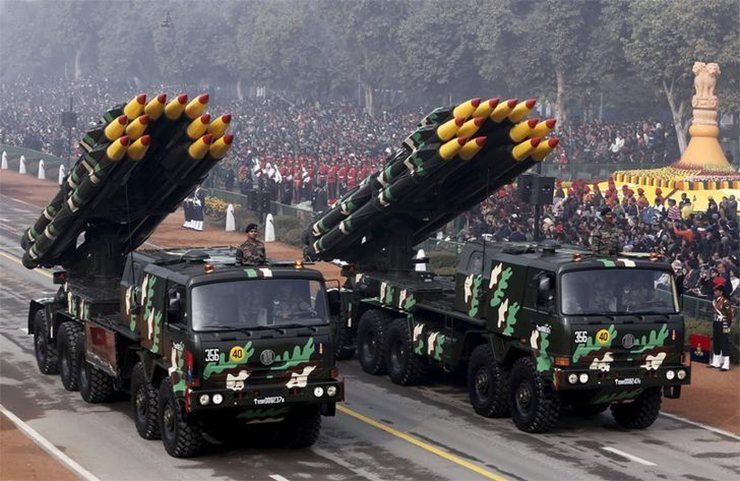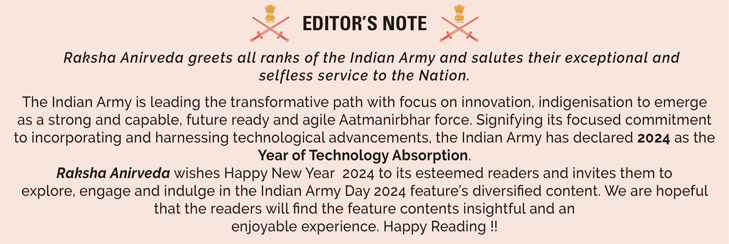
Rising phoenix-like from centuries of subjugation to foreign invaders and colonisers, India has become the fifth largest economy in three-quarters of a century, overtaking its erstwhile colonial masters. It’s well on the way to becoming the third largest economy in the next few years, but has a long way to go to catch-up with the U.S. and China, which will remain the two largest economies in the foreseeable future.
By some accounts, India has the second largest number of active military personnel, is the third largest regular contributor of troops to the UN Peacekeeping Missions, and ranks fourth in the global firepower index, and its military budget is the fourth largest in the world.
Ironically, in contrast to this, India is also the largest importer of arms. Stockholm International Peace Research Foundation (SIPRI) data reveals that India has held this position for close to two decades, except during 2005-09 when it was overtaken by China, and on other three occasions during 2014-18, 2015-19 and 2016-20 when Saudi Arabia surged ahead as the largest arms importer.
This timeframe is significant for two reasons. One, it coincides with the post-Kargil era of defence reforms, necessitated by the realisation that, among other things, self-reliance in defence production is crucial for national security and strategic autonomy, and that it could not be achieved without roping in the private sector. This led to several policy initiatives and structural reforms in the wake of the war. Successive governments have kept up the reform momentum.
In 2001 and thereafter, firstly the defence production sector was opened to private sector participation, foreign direct investment (FDI) was permitted up to 26 per cent, Headquarters Integrated Defence Staff was created to, inter alia, prepare defence plans for modernisation of the armed forces, detailed procurement procedures were formulated and documented, and a dedicated capital acquisition wing was set up within the Ministry of Defence to handle acquisitions.
Two, the government increasingly focussed on increasing domestic production and sourcing of military equipment from the Indian companies, especially the private sector entities and Micro, Small and Medium Enterprises (MSMEs).
Defence offsets were introduced in 2005 to strengthen the Indian defence industry. A ‘Make’ procedure was adopted in 2006 to promote indigenous design, development and production of high-tech complex systems. Offset banking was introduced in 2008 and the procedure for undertaking indigenous shipbuilding projects was simplified in 2011. A Defence Production Policy was also promulgated the same year.
In 2013, Technology Perspective and Capability Roadmap was notified to give an idea to the defence industry of the armed forces’ likely requirements over the ensuing fifteen years.
Based on the recommendations of the Committee of Experts constituted by the Ministry of Defence (MoD), a new procurement category, called ‘Buy (Indian – Indian Designed, Developed and Manufactured)’, was introduced in 2016 to incentivise design and development of military equipment by the Indian companies.
A Strategic Partnership Model was also adopted the same year for manufacturing aircrafts, helicopters, submarines, armoured fighting vehicles, and main battle tanks in India in collaboration with foreign manufacturers.
Since 2020, the Ministry of Defence (MoD) has notified 411 items, which will not be permitted for import with effect from the stipulated cut-off years. These items include a wide range of equipment, ranging from assault rifles to light combat aircraft, radars to satellite systems, expendable underwater targets to frigates, and ammunition to missiles.
In a parallel move, another 2,766 strategically important line replacement units, sub-systems and components have been identified for indigenisation by the Defence Public Sector Undertakings to minimise the imported content in production.
All this while, MoD’s focus has been on simplification of acquisition and offset procedures, easing of FDI norms which now permit investment up to 74 per cent through the automatic route, streamlining of industrial licensing process for the defence sector, and promulgation of schemes to incentivise innovation and technology development.
Out of the several, two such schemes stand out. One of these is the Technology Development Fund, managed by Defence Research and Development Organisation (DRDO). It aims at upgrading the existing products and systems, modernising processes and their applications, and development of futuristic technologies for defence. As many as 1,959 domain experts are presently working on indigenising 164 technologies, with DRDO’s financial assistance.
The other scheme called Innovations for Defence Excellence (iDEX) was launched in April 2018 to foster innovation and technology development in defence and aerospace by engaging the domestic industry, including the MSMEs, start-ups, individual innovators, R&D institutes, and academia.
Managed by not-for-profit Defence Innovation Organisation under the aegis of the Department of Defence Production, iDEX provides grants and other support to execute projects, which have the potential for adoption by the armed forces and meet the needs of the aerospace sector. As of December 2022, 310 such start-ups were working on 233 projects.
The Government of India has also established two Defence Industrial Corridors (DIC), one each in Uttar Pradesh (UP) and Tamil Nadu (TN), to attract investments in aerospace and defence sectors. As of March 2023, the UP government had signed 108 Memoranda of Understanding (MoUs) involving potential investment of Rs. 12,191 crore, while the TN government had signed 53 MoUs with potential investment of Rs 11,794 crore. Out of this, investment of Rs. 2,445 crore and Rs 3,894 crore has already been made in UP and TN corridors respectively.
In addition, there are many other small and big steps that successive governments have taken in the last two decades to achieve self-reliance in defence by incentivising indigenisation and transfer of technology to Indian companies by the foreign original equipment manufacturers (FOEMs). The question, however, is what has been the result of these efforts?
A PIB Press Release of December 2022 claimed that because of the initiatives taken by the government many state-of-the-art products are now being manufactured in India. These include 155 mm Artillery Gun system ‘Dhanush’, Light Combat Aircraft ‘Tejas’, Surface to Air Missile system ‘Akash’, Main Battle Tank ‘Arjun’, T-90 Tank, T-72 Tank, Armoured Personnel Carrier ‘BMP-II/IIK’, Su-30 MK1, Cheetah Helicopter, Advanced Light Helicopter, Dornier Do-228.
The list also includes High Mobility Trucks, INS Kalvari, INS Khanderi, INS Chennai, Anti Submarine Warfare Corvette (ASWC), Arjun Armoured Repair and Recovery Vehicle, Bridge Laying Tank, Bi-Modular Charge System (BMCS) for 155 mm Ammunition, Medium Bullet Proof Vehicle (MBPV), Weapon Locating Radar (WLR), Integrated Air Command and Control System (IACCS), Software Defined Radios (SDR), Lakshya Parachute for Pilotless Target Aircraft, Opto Electronic Sights for Battle Tanks, Water Jet Fast Attack Craft, In-shore Patrol Vessels, Off-shore Patrol Vessels, Fast Interceptor Boats, Landing Craft Utility, 25 T Tugs.
There is no doubt that the domestic defence industry has come a long way in the last 76 years since independence, and particularly in the past two decades. It is now capable of manufacturing a wide range of high-end platforms like tanks, armoured vehicles, fighter aircraft, helicopters, warships, submarines, missiles, as well as electronic equipment, special alloys, special purpose steels, and a variety of ammunition.
Most of these products are, however, either manufactured in India under license from the FOEMs, or depend on import of some critical sub-system or component, if not the design itself.
To illustrate, the indigenous content in the multirole Light Combat Aircraft Tejas, designed by Aeronautical Development Agency (ADA) in collaboration with Aircraft Research and Design Centre (ARDC) of Hindustan Aeronautics Limited (HAL) for the Indian Air Force and Indian Navy, is 59.7 per cent by value and 75.5 per cent by number of line replaceable units.
These percentages will undoubtedly be higher in Tejas Mark 1A and Mark 2, but the aircraft operates on an imported engine. While Tejas Mark 1 is currently powered by the U.S. multinational General Electric’s F404 IN20 engine and Mark 1A will also be powered by the same power plant, the heavier Tejas Mark 2 will be powered by a F414 INS6 engine by the same company.
Following Prime Minister Narendra Modi’s state visit to the US last month, a deal is in the offing under which General Electric is expected to transfer 80 per cent of the manufacturing technology of the F 414 engine to Hindustan Aeronautics Limited (HAL), but the moot point is whether with this technology transfer, will HAL be able to manufacture engines in future entirely on its own?
This is not to disparage the importance of the prospective deal, or indeed of the system of licensed production of military equipment, but to point out that true self-reliance, which is the sine qua non for self-reliance and strategic autonomy, comes from the mastery over design and development of all critical technologies that go into the manufacturing of military equipment, platforms, weapon systems, and other force multipliers.
In the absence of this capability, India remains vulnerable to denial of technology by the FOEMs because of unforeseen turn of events in international relations, thereby stymieing local production of defence material, which is dependent on those technologies.
For starters, MoD needs to rethink the policy of measuring self-reliance in monetary terms- i.e. expenditure incurred on procurement from the Indian companies- and focus on self-reliance in development of critical technologies, which constitute the core of the equipment operated by the armed forces. Indigenisation of sub-systems and components, though important and commendable, is not the stuff that genuine self-reliance is made of.
– The author is Ex-Financial Advisor (Acquisition), Ministry of Defence. The views expressed are personal and do not necessarily reflect the views of Raksha Anirveda.











